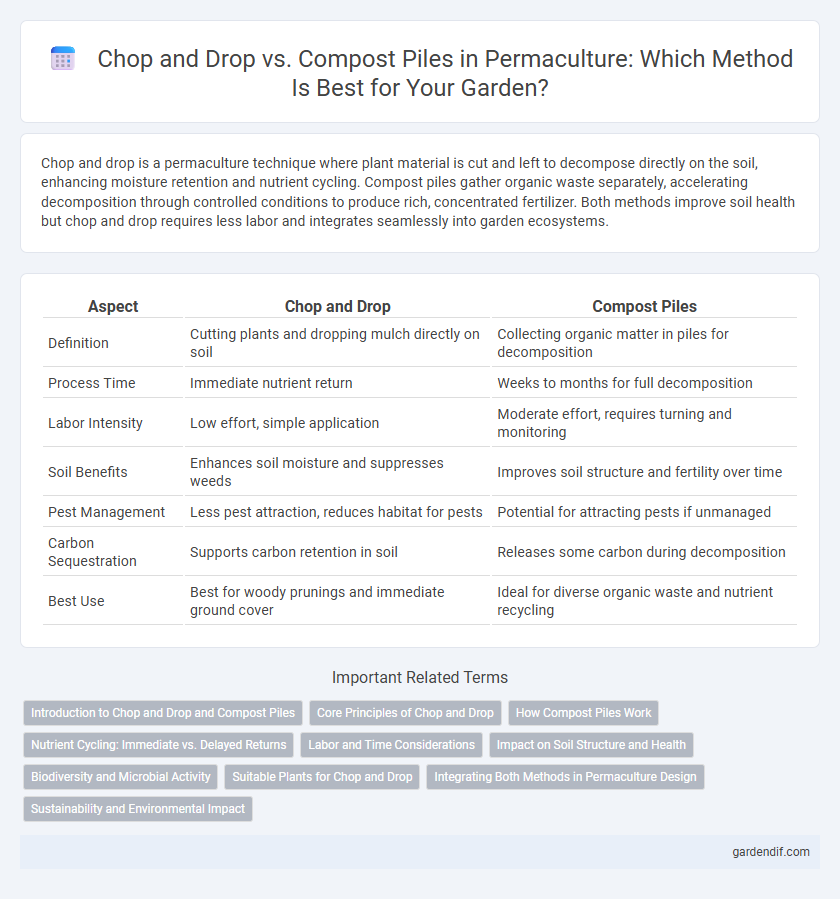
Chop and drop vs compost piles Illustration
Chop and drop is a permaculture technique where plant material is cut and left to decompose directly on the soil, enhancing moisture retention and nutrient cycling. Compost piles gather organic waste separately, accelerating decomposition through controlled conditions to produce rich, concentrated fertilizer. Both methods improve soil health but chop and drop requires less labor and integrates seamlessly into garden ecosystems.
Table of Comparison
| Aspect | Chop and Drop | Compost Piles |
|---|---|---|
| Definition | Cutting plants and dropping mulch directly on soil | Collecting organic matter in piles for decomposition |
| Process Time | Immediate nutrient return | Weeks to months for full decomposition |
| Labor Intensity | Low effort, simple application | Moderate effort, requires turning and monitoring |
| Soil Benefits | Enhances soil moisture and suppresses weeds | Improves soil structure and fertility over time |
| Pest Management | Less pest attraction, reduces habitat for pests | Potential for attracting pests if unmanaged |
| Carbon Sequestration | Supports carbon retention in soil | Releases some carbon during decomposition |
| Best Use | Best for woody prunings and immediate ground cover | Ideal for diverse organic waste and nutrient recycling |
Introduction to Chop and Drop and Compost Piles
Chop and drop is a permaculture technique where plants are cut and left on the soil surface to decompose naturally, enriching the soil with organic matter and nutrients. Compost piles involve collecting organic waste in a designated area to decompose into nutrient-rich humus through controlled aerobic decomposition. Both methods improve soil fertility, but chop and drop provides immediate ground cover, while compost piles require time for complete breakdown before application.
Core Principles of Chop and Drop
Chop and drop in permaculture emphasizes recycling organic matter directly on-site by cutting plants and allowing them to decompose naturally, enhancing soil fertility and moisture retention. This technique supports the core principles of soil protection, nutrient cycling, and minimal disturbance, promoting a self-sustaining ecosystem. Unlike compost piles, chop and drop reduces labor and carbon footprint by eliminating the need for transportation and turning of organic waste.
How Compost Piles Work
Compost piles accelerate organic matter breakdown by creating a controlled environment where microbes, fungi, and earthworms decompose plant material into nutrient-rich humus. The balance of carbon-rich (browns) and nitrogen-rich (greens) materials, along with sufficient moisture and aeration, enhances microbial activity and temperature regulation within the pile. This process results in nutrient-dense compost that improves soil structure, fertility, and water retention in permaculture systems.
Nutrient Cycling: Immediate vs. Delayed Returns
Chop and drop accelerates nutrient cycling by immediately returning organic matter and nutrients to the soil surface, enhancing microbial activity and soil fertility within a single growing season. Compost piles, while enriching soil with stabilized nutrients and organic matter, introduce a delayed return as decomposition can take weeks to months before nutrients become available to plants. Integrating chop and drop with composting optimizes nutrient availability by balancing rapid nutrient release and long-term soil amendment in permaculture systems.
Labor and Time Considerations
Chop and drop in permaculture significantly reduces labor and time by cutting plant material and directly mulching the soil, eliminating the need for transporting and managing compost piles. Compost piles require regular turning, monitoring moisture levels, and a waiting period of several months before the nutrient-rich soil amendment is ready for use. This method demands more physical effort and time investment compared to the immediate soil benefits provided by chop and drop techniques.
Impact on Soil Structure and Health
Chop and drop enhances soil structure by creating a natural mulch that retains moisture and promotes microbial activity directly on the planting site. Compost piles, while enriching soil with nutrients later, can disrupt soil organisms and require time before benefits are applied to the garden. By comparison, chop and drop supports immediate improvement of soil organic matter and fosters earthworm populations essential for soil aeration and nutrient cycling.
Biodiversity and Microbial Activity
Chop and drop enhances biodiversity by providing a continuous layer of organic matter that supports diverse soil organisms and promotes natural nutrient cycling. Compost piles accelerate microbial activity through concentrated decomposition, increasing the abundance of beneficial microbes essential for soil health. Both methods improve soil structure, but chop and drop fosters in situ microbial habitats, creating a more balanced and resilient ecosystem.
Suitable Plants for Chop and Drop
Suitable plants for chop and drop in permaculture include nitrogen-fixing legumes like clover and vetch, dynamic accumulators such as comfrey and comfrey-related symphytum species, and fast-growing shrubs like pigeon pea and mulberry, which provide nutrient-rich biomass. These plants decompose quickly on the soil surface, enhancing soil fertility and moisture retention without the labor-intensive process of managing compost piles. Integrating a diverse mix of chop and drop species promotes a sustainable nutrient cycle and supports healthy garden ecosystems.
Integrating Both Methods in Permaculture Design
Integrating chop and drop with compost piles enhances soil fertility by combining immediate organic matter mulching and nutrient-rich humus production. Chop and drop accelerates nutrient cycling by directly feeding the soil surface, while compost piles break down more complex materials into stable compost, enriching soil microbial life. Leveraging both methods within permaculture design maximizes resource efficiency, reduces waste, and sustains long-term ecosystem health.
Sustainability and Environmental Impact
Chop and drop mulching enhances soil fertility by naturally decomposing plant matter directly on site, reducing waste and minimizing carbon emissions associated with transporting compost materials. Compost piles can improve soil structure and nutrient content but often require energy for turning and can produce methane if not managed properly. Emphasizing chop and drop practices supports sustainable permaculture by fostering a closed nutrient loop and promoting ecological balance.
Chop and drop vs compost piles Infographic

 gardendif.com
gardendif.com